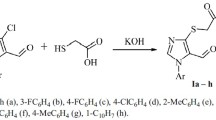Abstract
The effect of O-phenanthroline (OP) on mechlorethamine hydrochloride (HN2) toxicity was studied in in vitro and in vivo experiments. Incubation of HN2 with the in vitro rat liver slice system resulted in leakage of alanine aminotransferase (ALT) in a time-dependent manner. Exposure of the slices to HN2 for 4 h caused 79.2% ALT leakage. In the presence of OP enzyme leakage was reduced to 28.7%. OP-induced protection was shown to be dose dependent. Other metal chelators such as dithiothreitol (DTT) and EDTA (ethylenediaminetetraacetic acid) had a weak effect on HN2 cytotoxicity. The protective activity of OP was also demonstrated in in vivo skin toxicity studies in the guinea pig. The ulcerative effect of topically applied HN2 was inhibited by OP even when applied 10 min following the alkylator. Histology of NH2-treated skin showed epidermal ulceration associated with a covering layer of encrusted exudate. However, only a slight diffuse acanthosis of the epidermal layer was observed when OP was applied 10 min after the vesicant. It is suggested that OP may be used for the prevention of tissue damage caused by antineoplastic treatment with nitrogen mustard. It might also be employed in military medicine as an antidote to the chemical weapon sulfur mustard.
Similar content being viewed by others
References
Ball R, Connors TA (1967) Reduction of the toxicity of “radiomimetic” alkylating agents by thiol pretreatment-VI. The mechanism of protection by cysteine. Biochem Pharmacol 16: 509–519
Colvin M (1982) The alkylating agents. In: Chabner B (ed) Pharmacological principles of cancer treatment. WB Saunders Company, Philadelphia, pp 276–308
Connors TA (1966) Protection against the toxicity of alkylating agents by thiols: the mechanism of protection and its relevance to cancer chemotherapy. Eur J Cancer 2: 293–305
Contractor SF (1963) Protection against nitrogen mustard by cysteine and related substances, investigated using [3H]methyl-di(2-chloro-ethyl) amine. Biochem Pharmacol 12: 821–832
DeNeve WJ, Everett CK, Suminski JE, Valeriote FA (1988) Influence of WR2721 on DNA cross-linking by nitrogen mustard in normal mouse bone marrow and leukemia cells in vitro. Cancer Res 48: 6002–6005
Dorr RT, Soble M, Alberts DS (1988) Efficacy of sodium thiosulfate as a local antidote to mechlorethamine skin toxicity in the mouse. Cancer Chemother Pharmacol 22: 299–302
Goldenberg GJ, Sinha BK (1973) Protection of L5178Y lymphoblasts by choline and ethanolamine against cytocidal effect of nitrogen mustard in vitro. Cancer Res 33: 1253–1257
Goldenberg GJ, Vanstone CL, Bihler I (1971) Transport of nitrogen mustard on the transport carrier of choline in L5178Y lymphoblasts. Science 172: 1148–1149
Nagy B, Grdina DJ (1986) Protective effects of 2-[(aminopropyl)amino] ethanethiol against bleomycin and and nitrogen mustard-induced mutagenicity in V79 cells. Int J Rad Oncol Biol Phys 12: 1475–1478
Naujokaitis SA, Fisher JM, Rabinovitz M (1984) Protection of murine L1210 leukemia and bone marrow progenitor cells against mechlorethamine and inhibition of choline uptake as a structure-activity relationship of 2-dimethylaminoethanol and its analogues. J Pharm Sci 73: 34–39
Sauter C, Cogoli M, Arrenbrecht S, Marti C (1984) Neutralization of cis-dichlorodiammineplatinum II and nitrogen mustards by thiols. In: Hofmann V, Berens ME, Martz G (eds) Recent results in cancer research, predictive drug testing in human tumor cells, vol 94. Springer-Verlag, Berlin, Heidelberg, New York, pp 232–236
Therkelsen AJ (1961) Protection of cells in tissue culture by means of cysteamine and cystamine against the action of nitrogen mustard and X-rays. Biochem Pharmacol 8: 269–279
Walker IG, Smith JF (1969) Protection of L-cells by thiols against the toxicity of sulfur mustard. Can J Pharmacol Physiol 47: 143–151
Wormser U, Ben-Zakine S, Stivelband E, Eizen O, Nyska A (1990) The liver slice system: a rapid in vitro acute toxicity test for primary screening of hepatotoxic agents. Toxic In Vitro 4: 783–789
Author information
Authors and Affiliations
Rights and permissions
About this article
Cite this article
Wormser, U., Nyska, A. Protective effect of O-phenanthroline against mechlorethamine toxicity in the rat liver slice system and in the guinea pig skin. Arch Toxicol 65, 666–670 (1991). https://doi.org/10.1007/BF02098034
Issue Date:
DOI: https://doi.org/10.1007/BF02098034




